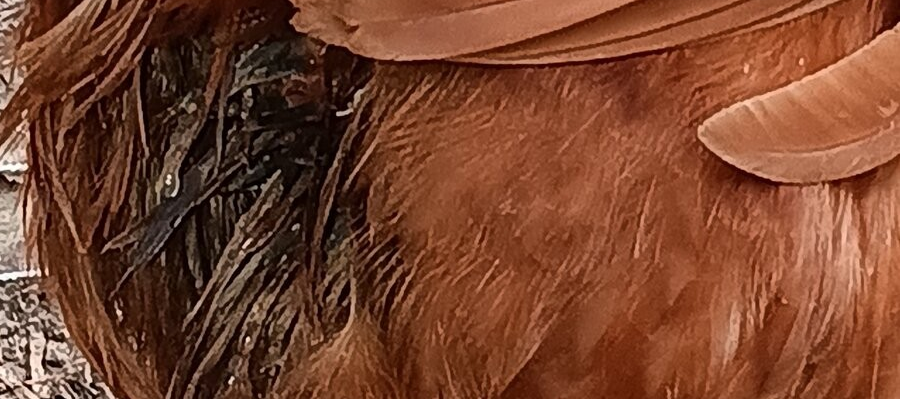
Vent gleet, also known as cloacitis, might sound like a fancy term, but it’s simply an inflammation and infection of a chicken’s vent, the area where they expel waste and lay eggs. It’s essentially a yeast infection similar to those in other animals and even humans.
Knowing about vent gleet is super important for anyone raising chickens because it directly affects their health and egg production. Chickens are surprisingly vulnerable to various infections, and this one, in particular, can be quite uncomfortable for them.
You’ll find vent gleet popping up more than you might expect, especially in backyard flocks. It’s not picky about the birds it targets, either—practically any chicken can fall victim, making it something all poultry keepers should be aware of.
Causes of Vent Gleet
Vent gleet doesn’t just appear out of nowhere; it often starts with something seemingly mild, like a simple diet change. Giving chickens too many treats or foods they’re not used to can mess with their digestive system and cause trouble. Keeping a balanced diet is crucial for their health.
Environmental factors play a big role, too. Damp, dirty coops are like open invitations for bacteria and fungi to party. Chickens thrive in clean, dry spaces. Make sure their living conditions are kept fairly clean, with constant checks and clean-ups to prevent infections.
A coop should be cleaned once a week to get as much of the manure and broken eggshells and treat leftovers and any other debris that shouldn’t be there.

I make a point of clearing broken eggs immediately upon finding them. If they are in a nesting box, WOOSH; new nesting box shavings (or whatever you use). I also use Happy Hen Nesting Herbs to freshen the boxes.
What do the herbs smell like? Next time, sniff a few boxes of Celestial Seasons tea at the grocery store. The sweetest one you find is probably pretty close.
The Aromatic Blend includes Lavender, Raspberry Leaf, Jasmine, Rosemary, Peppermint, Nettle Red Clove, Thyme, Marigold, Chamomile, and Oregano.
Keep an eye on stress as it can also trigger vent gleet. Chickens, much like humans, have a hard time under stress, whether it’s from overcrowding, predators, or even just too much handling. Having enough space and minimizing stressors can do wonders in keeping vent gleet at bay.
Each chicken might react differently, but understanding these risk factors helps create a healthy environment. Regular observations and adjustments to their care routine can prevent vent gleet from starting.
Recognizing the Symptoms of Vent Gleet
Spotting vent gleet early can save your chickens a lot of discomfort. I see many questions about gleet in the Backyard Chicken Forum, and many want to know if their chickens have it. Here are a few ways to tell.
Notice any changes around the vent, like redness, swelling, or discharge; you’ve got your first clues. These symptoms suggest something isn’t right down there.
A telltale sign is the unpleasant smell—almost like something sour—lingering on the feathers around the vent. Sticky and matted feathers can also be the flashing red signal pointing toward vent gleet. Keep your eyes open for these warning signs during routine checks.
Chickens with vent gleet may seem slightly off, showing signs like being less active, not eating as much, or reducing egg production. Noting these behaviors can save you from bigger headaches later on.
Be mindful not to confuse vent gleet with other illnesses. Some poultry diseases have similar symptoms but require different treatments. Knowing the distinct signs of vent gleet ensures your chickens get the necessary care.
Other illnesses could be:
- Candidiasis (Thrush): This is a fungal infection caused by Candida albicans, similar to vent gleet. It can cause a white, cheesy discharge and a strong odor.
- Egg Binding occurs when a hen cannot pass an egg, leading to swelling and discharge around the vent.
- Internal Parasites: Parasites like worms or protozoa can cause digestive issues and discharge, which might be mistaken for vent gleet.
- Cloacal Prolapse is when the cloaca protrudes outside the body, often accompanied by discharge and inflammation.
Of course, if you’re unsure of your diagnosis, ask a veterinarian. Better safe than sorry.
Prevention and Potential Consequences of Untreated Vent Gleet
Prevention is the key when dealing with vent gleet. Regular cleaning of their environment keeps those pesky bacteria and fungi at bay. Aim to maintain a clean, dry coop to give chickens a healthy space to call home.
Diet forms the backbone of a prevention strategy. Ensure your chickens eat a balanced diet filled with all the necessary nutrients. Avoid too many snacks or sudden changes in their meals to help their guts stay strong.
Addressing stress points is another major preventive step. Keep overcrowding in check, create predator-safe surroundings, and handle with care to reduce anxiety that could pave the way for vent gleet.
Leaving vent gleet untreated isn’t the best idea. Without intervention, it can lead to long-term health issues and even significantly affect egg production. Acting swiftly when symptoms appear helps prevent further complications and supports recovery.
Early treatment means less worry about enduring scars or more severe secondary infections. Offering a bit of extra love and care through preventative measures can make all the difference in keeping your flock content and healthy.
Treat your affected chickens by bathing their bottoms and applying an antifungal like miconazole. You can also give them extra electrolytes and probiotics to help heal their guts. However you choose to heal your birds, I wish you and them well.
Dave

Chickenmethod.com

